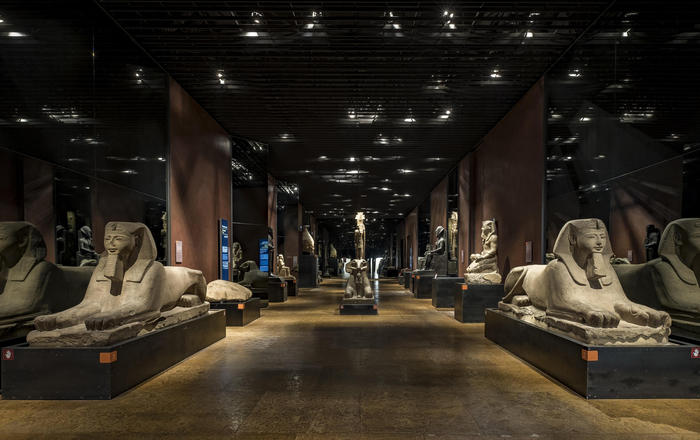ROME - In the splendid gardens of Villa Adriana and Villa d'Este, in Tivoli, nature has become once again the protagonist. Free from the crowd of tourists, plants and world heritage paths have started to breathe again, lovingly cared for by the park's gardeners.
"It could not be otherwise - explains Andrea Bruciati, for three years at the helm of the complex that collects the Renaissance Villa d'Este together with the remains of the villa of delights of Emperor Hadrian and the sanctuary of Hercules - the maintenance of greenery here is essential , as well as engineering for the complex functioning of fountains and streams. " The stop forced by the coronavirus emergency has therefore become for this very special slice of the Italian heritage, "a time of regeneration", and also the occasion for a remodeling, underlines Bruciati, "that it would have been impossible to do in the presence of the public". This is not the case at the Egyptian museum in Piedmont targeted by the epidemic. "Here we are all in smart working", says Christian Greco, director of the Turin foundation. Pharaohs and beetles, as well as the precious papyri, have been resting for weeks, as if it were always night, protected by the air conditioning system and by a heavily reinforced armed vigilance. Equipped with lap tops and vpn for access to the archives, the 59 staff workers are busy between study, research, cataloging, but also to carry out the administration, remotely solve the problems caused by the stop, such as the flooding of the archaeological excavation that had just started in Saqarah, Egypt. However, we have to deal with the economic disaster: "We asked for recourse to the CIG provided by Cura Italia - regrets Greco - We live on our budget, which is made up of 68% of tickets and the rest of initiatives and traveling exhibitions, with this stop we lose 34 thousand euros a day. " Not to mention the exhibitions stuck abroad. One in São Paulo in Brazil, another in Kansas City in the USA, a third in Ottawa in Canada.
These too are blows to the budget. So much so, the insurance policies, at least, have all been extended. From Piedmont to Puglia, there is the case of the archaeological museum of Taranto, the imposing Marta, much poorer in terms of visitors, but in recent years increasingly felt as a garrison of culture in a particularly difficult territory: "For the city a very serious damage ", complains the director Eva Degli Innocenti, who organizes a team of workers in smart working. Here too, space has been given to the practices that can be followed remotely, from cataloging finds to publications. For those who could not be converted back to work from home, language and training courses were invented. But many energies are engaged on the online which guarantees contact with the population. "And the answer is, we've had half a million unique users in recent weeks." The relationship with the territory is a strong point also for the Archaeological Park of Paestum, in Campania: here Gabriel Zuchtriegel leads a team of 80 people. All in smart working, except for the surveillance and maintenance workers. Space for study, research, development of data from the latest excavations, publications, online content communication. But not only: "we thought it was right to use this time to share skills and knowledge among us", explains the 40-year-old German archaeologist. And so everyone began to teach others the things in which he has perfected or discovered in recent years, from accessibility for the public with disabilities, to communication techniques, from the foundations of archeology to the latest theories on discoveries. "So when it finally reopens we will all be more prepared."
The example of Pompeii is different, beautiful and poignant in the postcards posted in these days by the director Massimo Osanna: here, where the conclusion of the Great restoration project had just been celebrated, only the guardians and a maintenance team remained. Everyone else works from home: "We are going through the bureaucratic procedures so we are ready for when we get out of the emergency," says Osanna. In fact, a lot to do for everyone, from tenders to publications, from the systematization of the data collected in the excavation campaigns to the executive projects for the protection of the domus brought to light in recent months. Here too, the economic weight of the stop will be violent ("the average annual collection was 40 million euros, this year we will not be able to exceed 10 million") and there is no lack of concern for the remains stuck abroad. One for all, the extraordinary "treasure of the sorceress", among the most beautiful surprises of the last excavation campaign: the Parisians had booked themselves in droves to admire it in an exhibition that was due to open on March 23rd. Shipped to France in time, stones and amulets now lie in the vault of the Grand Palais. Again in the dark, as it has been for so many centuries. (HANDLE).
From studies to gardening, quarantine in museums
2020-03-28T09:24:24.052Z

In the splendid gardens of Villa Adriana and Villa d'Este, in Tivoli, nature has come back overwhelmingly. (HANDLE)





/cloudfront-eu-central-1.images.arcpublishing.com/prisa/6UILSHI4OVDJJMD2GLI5FLRMZY.jpg)



/cloudfront-eu-central-1.images.arcpublishing.com/prisa/S7ERVSCT4FUVX6R7TUVBDNTH5Y.jpg)



